Abstract
Eye guide is an assistive specialized apparatus intended for the incapacitated or physically disabled individuals who were not able to move parts of their body, especially people whose communications are limited only to eye movements. The prototype consists of a camera and a computer. The system recognizes gazes in four directions and performs required user actions in related directions. The detected eye direction can then be used to control the applications. The facial regions which form the images are extracted using the skin color model and connected-component analysis. When the eye regions are detected, the tracking is performed. The system models consist of image processing, face detector, face tracker, and eyeblink detection. The eye guide system potentially helps as a computer input control device for the disabled people with severe paralysis.
Access this chapter
Tax calculation will be finalised at checkout
Purchases are for personal use only
References
Ebisawa Y (1998) Improved video-based eye-gaze detection method. IEEE Trans Instrum Meas 47(4):948–955
Kim KN, Ramakrishna RS (1999) Vision-based eye-gaze tracking for human computer interface. In: 1999 IEEE international conference on systems, man, and cybernetics, 1999. IEEE SMC’99 conference proceedings, vol 2. IEEE, pp 324–329
Galante A, Menezes P (2012) A gaze-based interaction system for people with cerebral palsy. Procedia Technol 5:895–902
Mahalakshmi E, Sheeba GM (2015) Enhancement of CFA in single sensor camera using laplacian projection technique. Res J Pharm Biol Chem Sci 6(3):1529–1536
Magee JJ, Betke M, Gips J, Scott MR, Waber BN (2008) A human–computer interface using symmetry between eyes to detect gaze direction. IEEE Trans Syst, Man, Cybern Part A Syst Humans 38(6):1248–1261
Al-Rahayfeh AMER, Faezipour MIAD (2013) Eye tracking and head movement detection: a state-of-art survey. IEEE J Transl Eng Health Med 1:2100212
Rantanen V, Vanhala T, Tuisku O, Niemenlehto PH, Verho J, SurakkaV, Juhola M, Lekkala JO (2011) A wearable, wireless gaze tracker with integrated selection command source for human–computer interaction. IEEE Trans Inf Technol BioMedicine 15(5):795–801
Carbone A, Martínez F, Pissaloux E, Mazeika D, Velázquez R (2012) On the design of a low cost gaze tracker for interaction. Procedia Technol 3:89–96
Zhang L, Vaughan R (2016, October) Optimal robot selection by gaze direction in multi-human multi-robot interaction. In: 2016 IEEE/RSJ international conference on intelligent robots and systems (IROS).IEEE, pp 5077–5083)
Miyake T, Asakawa T, Yoshida T, Imamura T, Zhang Z (2009, November). Detection of view direction with a single camera and its application using eye gaze. In: 35th annual conference of IEEE industrial electronics, 2009. IECON’09, pp 2037–2043
Merlin Sheeba G (2016) Enhanced wavelet OTSU tracking method for carcinoma cells. Int J Pharm Technol 8(2):11675–11684
Santos R, Santos N, Jorge PM, Abrantes A (2014) Eye gaze as a human-computer interface. Procedia Technol 17:376–383
Sun L, Liu Z, Sun MT (2015) Real time gaze estimation with a consumer depth camera. Inf Sci 320:346–360
Acknowledgements
Ethical Compliance Comments
Figure 4 is a facial image taken from UCI repository dataset as an example to indicate the focal and seat points in the face.
Author information
Authors and Affiliations
Corresponding author
Editor information
Editors and Affiliations
Rights and permissions
Copyright information
© 2019 Springer Nature Switzerland AG
About this paper
Cite this paper
Sheeba, G.M., Memala, A. (2019). Detection of Gaze Direction for Human–Computer Interaction. In: Pandian, D., Fernando, X., Baig, Z., Shi, F. (eds) Proceedings of the International Conference on ISMAC in Computational Vision and Bio-Engineering 2018 (ISMAC-CVB). ISMAC 2018. Lecture Notes in Computational Vision and Biomechanics, vol 30. Springer, Cham. https://doi.org/10.1007/978-3-030-00665-5_164
Download citation
DOI: https://doi.org/10.1007/978-3-030-00665-5_164
Published:
Publisher Name: Springer, Cham
Print ISBN: 978-3-030-00664-8
Online ISBN: 978-3-030-00665-5
eBook Packages: EngineeringEngineering (R0)

